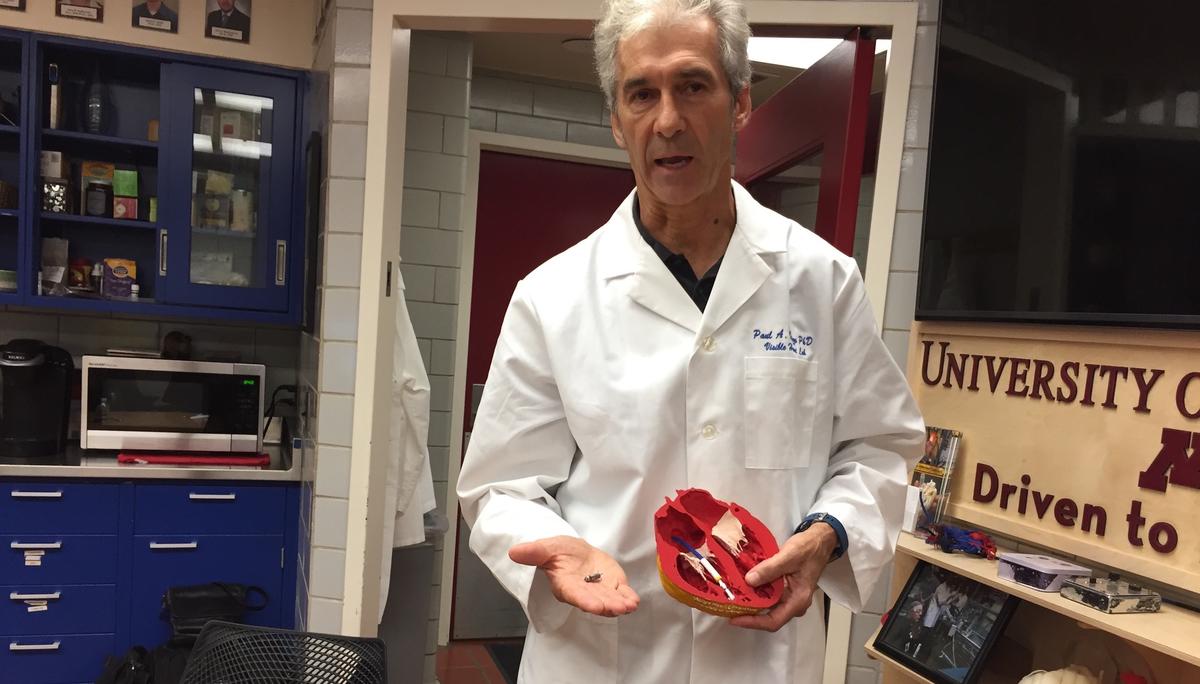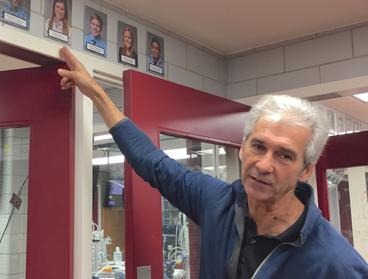Paul Iaizzo, Ph.D. ’78/’80 gives a tour of the many rooms in the Visble Heart® Lab on the campus of the University of Minnesota. In every room, he recounts experiments, developments, and stories of lives saved.
In one room, visitors are invited to don a pair of virtual reality (VR) goggles. As they open their eyes, they appear to be standing inside a room-sized replica of an actual person’s heart. By moving their heads sideways or up and down, they see the interior of the heart. They use a pointer to move the image forward, traveling outside the heart or through valves into the four chambers.
Paul watches on a monitor and explains how the image was created. “We took an MRI and used it to create a 3-D printed heart model. Then we expanded the model in virtual reality,” he says.
A Heart Library
The VR images are just one of the tools the Visible Heart Lab uses to educate clinicians, engineers, patients, and students of all levels. “Our library has documented more than 5,000 hearts as downloadable images and movies,” he says. Many of them include tutorials.
There’s also a room full of 3-D models where 3-D printers continually hum. “This is a replica of the damaged heart of a young girl," he says, holding up a model. "She is doing well after her transplant.”
Every heart surgery presents a completely unique problem to solve where a heart in the library may have the answer. “Hearts are like fingerprints, they are unique to each of us," Paul explains.
Support for Heart Transplants
Visible Heart Lab is the only lab in the world that reanimates large mammalian hearts outside the body using a fluid called clear perfusate, which allows functional cardiac anatomy to be visualized. "Our lab has made medical history by reanimating 78 human hearts since 2000," Paul says. These hearts were gifted to the lab for research via a program called LifeSource. The hearts are from families of organ donors, whose hearts were not considered viable for transplantation.
In one project, Paul and the Visible Heart Lab team are assisting a larger effort. They are working on finding ways to extend the time a donor heart can safely be kept outside the body.
While previously, a heart from a donor could only be kept viable for 4-6 hours, through their work on pre- and postconditioning of hearts, Paul’s team has been able to extend the time to 24 hours in the lab. The TransMedics Organ Care System, a traveling high-tech container, is being developed by MedTronic to replicate lab conditions and offer content monitoring while the heart is in transit. “The process will allow people all over the world to have access to heart transplants,” he says.
Paul’s research team made the news in summer 2017, when they helped surgeons better understand, pre-clinically cardiac requirements to separate conjoined twins. His teams created 3-D computational and printed models, and aided the surgeons to come up with optimized pre-surgical plan.
The UMD Connection
A native of White Bear Lake, Paul attended UMD for his 1978 B.S in biology and his 1980 M.S. in physiology. He went on to get his Ph.D. from the UM in 1986. He is still in contact with his UMD professors, George Trachte at the University of Minnesota Medical School, Duluth Campus and Robert Pozos, who is now at San Diego State University.
Some of his favorite memories from his time at UMD are running the Hartley Nature Area trails, following Congdon Creek down to Lake Superior, and exploring Hawk’s Ridge. He continues to canoe, fish and hike the Boundary Waters Canoe Area, a tradition he started with UMD friends. “We’d pile in a car and head north for the weekend,” he says.
Recreation mixes with research in Paul’s current bear hibernation studies. He works on a project where a monitor is placed inside a bear’s heart and data is recorded all winter. “I still get up north,” he says.
His days are filled with team projects and work on his individual research yet he still makes time to give presentations. In October 2017, Paul returned to the Duluth campus to give a much appreciated presentation to medical school students.
More about Paul Iaizzo
Visible Heart Lab, University of Minnesota, Twin Cities
Paul Iaizzo's primary research focus is translational systems physiology, and his research group has developed a unique isolated working large mammalian heart model. The Visible Heart Laboratory is well known for its novel imaging techniques of cardiac anatomy and physiology, and is an ideal place to perform translational systems physiology research. Other research interests include cardiac pacing, skeletal muscle pathophysiology, thermoregulation, black bear hibernation, wound healing, and spine biomechanics. Paul has authored more than 180 original articles, edited four books, and holds multiple patents (both U.S. and European) related to cardiac anatomy, physiology, and devices.
Video of Dr. Iaizzo's Research
About the Department of Biology
About the UM Medical School, Duluth Campus

